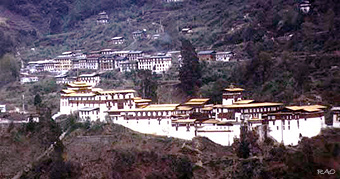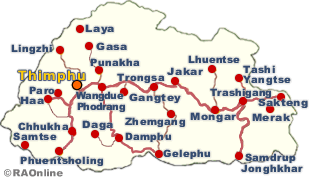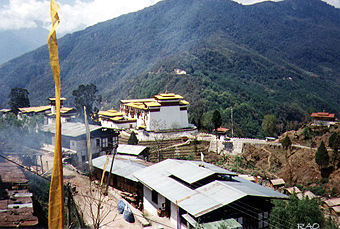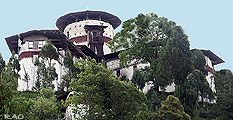 |
Bhutan Politics |
|
 |
Bhutan Politics |
 |
|
|
| A
historical background of the Chhoetse Penlop |
 |
 |
| Trongsa Dzong |
| The
royal institution of the Chhoetse Penlop (later called Trongsa Penlop)
goes back more than 350 years into Bhutanese history when Zhabdrung
Ngawang Namgyel unified the scattered population that was spread over
a vast expanse of rugged mountain territory and established a stable system
of national governance. |
|
According
to the accounts of researchers and scholars who have studied the unique
blend of mythology and history that represents Bhutan's past, the Zhabdrung
had appointed Chhoeje Minjur Tenpa as his representative in Trongsa in
the 1640s.
Yongzin
Ngagi Wangchuck had founded the Trongsa Dzong. Born in 1517 to Lam Ngawang Chhoejay he was guided, in a vision, by the guardian
deity, Palden Lhamo, to go to a place in central Bhutan which resembled
a bow and which was abundant in food grains (mang-dru).
The
name Mangdue has its origin in this word. Accordingly, Pal Ngagi
Wangchuk arrived in Trongsa in 1541 where he took residence in the village of Yueli which was located on the
northern hill slopes overlooking the then bare hillock upon which the Trongsa
Dzong presently stands.
One
night while Pal Ngagi Wangchuk was meditating his attention was
drawn by a flicker of light, resembling that of a butter-lamp burning in
the open air, at the spot where the present day Goenkhang of the Trongsa
Dzong is located. Upon visiting the spot, he was deeply overwhelmed
by discovering the Lhamoi Latsho (sacred lake of Palden Lhamo) and
the hoof prints of Palden Lhamo's steed.
In 1543, Pal
Ngagi Wangchuk established a small Tsamkhang (meditation quarter) in the sacred spot and named it "Mon Drubdey". He soon attracted
a number of disciples who built their own meditation units around the main
Tshamkhang. The cluster of newly built meditation quarters appeared to
the people of Yueli above like a new village and hence they called it "Trongsar"
meaning "new village".
By
the time Zhabdrung Ngawang Namgyel was fifty-two years (1646),
he had succeeded in bringing the whole of western Bhutan under the theocratic
rule he had established. He turned his attention to the east and decided
to establish a seat of authority in Trongsa which would, considering its
strategic location between the east and west, play a crucial role in the
unification of the country.
 |
| At
that time, there were many feudal rulers in eastern Bhutan, mainly in Bumthang,
Lhuentse, Trashigang and Zhemgang. The Zhabdrung found Chhogyel
Minjur Tenpa, a close confidante and a person of unquestionable loyalty
and integrity, the most suitable candidate for the daunting task of unifying
and consolidating the whole of eastern Bhutan under his rule. |
|
Chhoeje
Minjur Tenpa unified eastern Bhutan into eight provinces, known as
"sharchog khorlo tsibgay", and brought them under the rule of the
Zhabdrung. Seeing the unification of the eastern region as an auspicious
symbol, the Zhabdrung instructed Chhoeje Minjur Tenpa to
construct a dzong as the seat of Yongzin Ngagi Wangchuk and Mepham Tenpai
Nima in the centre of the Mangdue region.
Chhoeje
Minjur Tenpa constructed the dzong in 1644 and named it the Druk Minjur Chhoekhor Rabten Tse, which translates
as "the Dzong built on the tip of a dungkhar (conch) of the never changing
land of Druk where the dharma is everlasting". It described the shape
of the hillock holding the Dzong and the name of the builder.
In 1647, Chhoeje
Minjur Tenpa was appointed as the Chhoetse Chila, the title
derived from the dzong. The dedicated efforts of Chhogyel Minjur Tenpa and subsequent governors of Trongsa gradually led to the expansion of Trongsa
Dzong.
While
the meditation centre of Yongzin Ngagi Wangchuk was initially known
as Trongsar the lams were known as "Chhoetse Chila" or "Trongsa Chila",
in keeping with the name of the Dzong, when Zhabdrung Ngawang Namgyel started appointing lams for the community from the religious body. The
word "Chila" was used to describe ordained monks. However, with
the passage of time, since non-monk chiefs were appointed to the post,
the title "Chhoetse Penlop" came to be used, replacing Chila with
Penlop.
 |
| Trongsa Dzong |
| Three
important administrative zones, with the headquarters for the southern
zone in Dagana, the eastern zone in Trongsa, and the western zone
in Paro, were established. |

|
|
Ta
Dzong in Trongsa
|
|
The Zhabdrung also established the institutions of the Paro Penlop and Daga Penlop to
head different administrative zones. Chhoejay La Noenpa Tenzin Drugdra
was appointed as the Paro Penlop, Tenpa Thinley as the Daga Penlop and
Chhogyel Minjur Tenpa as the Trongsa Penlop in 1647.
Since then the tradition of appointment of Trongsa Penlop has continued.
The Penlops were direct representatives of the Zhabdrung, bestowed
with authority to make independent decisions on his behalf and govern according
to the administrative and judicial code established by him.
In 1853, Jigme
Namgyel became the Trongsa Penlop. Twenty-nine years later,
in the year 18882,
his son Ugyen Wangchuk became the Trongsa Penlop. With the birth
of the Bhutanese monarchy in 1907,
the position of the Trongsa Penlop assumed special significance.
Gongsar
Ugyen Wangchuck was the Trongsa Penlop when the Bhutanese clergy,
the government, and the people unanimously elected him as the first hereditary
King and established a new era of Bhutanese history. His Majesty King
Ugyen Wangchuck served as the Trongsa Penlop between 1882 and 1907 and it was in Trongsa that the people of Bhutan offered their love, their
reverence, and their allegiance to their Monarch.
The
institution of the Trongsa Penlop, therefore, came to signify the true
heritage to the Bhutanese Throne and the investiture ceremony of the Trongsa
Penlop became the formal declaration of this status of the Crown Prince.
His
Majesty King Jigme Singye Wangchuck was installed as the Trongsa Penlop
on May 15, 1972,
at the age of 16 years. The lhengye zhungtsho announced this year that
the revered position of the Trongsa Penlop would once again be known by
the historical term, Chhoetse Penlop as the Crown Prince represents
all the 20 dzongkhags of the kingdom.
With
the formal awarding of the Gyalse Ngadun which signifies mastery
over worldy and spiritual matters, miraculous accomplishment, inexhaustible
speed and strength and the trinity of love wisdom and power, and the celebration
of the traditional ceremonies in Trongsa, His Royal Highness Dasho Jigme
Khesar Namgyel Wangchuck will be the 16th Chhoetse Penlop.
 |
| This
article was contributed by Kuensel, Bhutan's national newspaper 2005 |
| December
14, 2006 |
 |
| His
Majesty King Jigme Singye Wangchuk said that the responsibilities of the
Throne would be delegated to the Chhoetse Penlop before 2008. His Royal
Highness Jigme Khesar Namgyel Wangchuck will be enthroned as the fifth
Druk Gyalpo in 2008. |
|
|
|
|







